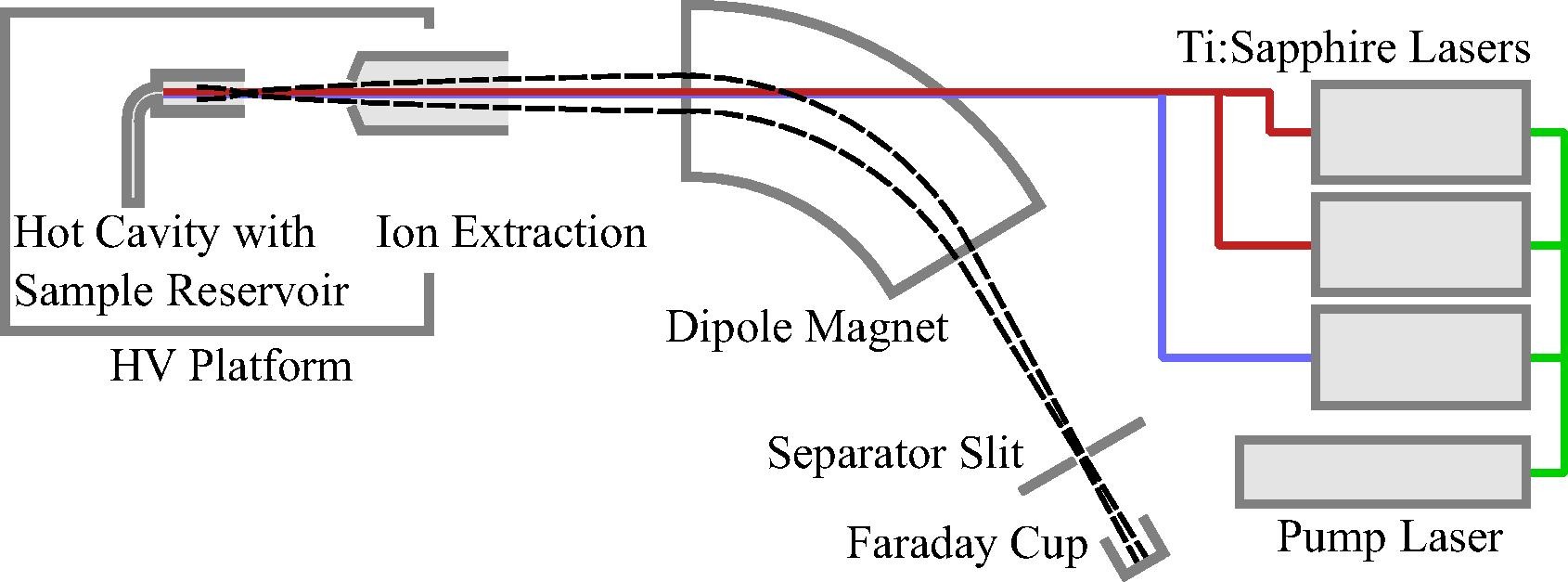Charged particles can be manipulated, transported, separated or trapped within of electromagnetic fields. Therefore, devices for the ionization of neutral atoms are found as fundamental parts of many experiments in the field of atomic and subatomic systems. Ion sources of different types are used at the world-leading facilities for production of exotic, short-lived radioactive elements and isotopes. While detailed understanding of the physical processes inside the source is essential for operating, also dedicated experiments can be conducted in the source itself, yielding new information on the structure of the investigated nuclides.
The LARISSA group is specialized on development and optimization of ion sources based on the technique of laser resonance ionisation spectroscopy. Therefore, matter is evaporated and atomized in a hot cavity furnace. By using precisely tuned laser radiation, a ground state electron of the atom undergoes step-wise resonant transitions to excited states, finally gaining enough energy to be separated from the atom. As these excited states are unique for every chemical element, one single element can be ionized selectively by appropriate adjustment of the laser wavelengths. The ions are then extracted as a beam using electrodes, and by subsequent mass selective elements such as quadrupole mass filter or dipole magnets, ions of one desired mass can be chosen. The combination of the highly efficient and highly element selective resonant laser excitation and subsequent mass separation yields isotopic pure ion beams, which can be delivered to experiments or detected directly.
The development of these ion sources at the LARISSA group aims at several aspects:
- The temperature distribution of the ion source is optimized by structural changes to improve the extraction.
- New laser excitation schemes are developed in systematic studies, enabling higher ionization efficiency
- The ion beam may contain contaminations, stemming from different mechanisms such as surface ionization at the hot furnace walls. The LIST ion source concept comprises active suppression of these contaminants in the source itself.
- The spectral resolution in the source is limited by the Doppler broadening of the resonances in the hot atom vapor. For high resolution laser spectroscopy studies on the hyperfine structure splittings of the transitions, dedicated geometry concepts for the interaction of laser beams and atoms are developed.
Ion source development and spectroscopic experiments on stable and long-lived radioactive isotopes take place at the Institute of Physics in Mainz, at a 30kV mass separator with a dedicated, home-built titanium:sapphire laser system. Results and developments are distributed and shared in close collaborations with facilities world-wide, such as CERN-ISOLDE, and contribute to state-of-the-art atomic and nuclear science.
 |
| Laser system at the RISIKO off-line mass separator |
The requirements for a pulsed laser system for use in a laser ion source are: narrow line width for high selectivity, high pulse power, short pulse duration, good beam quality, wide tuning range and easy handling. Due to a high peak intensity it is possible to saturate the optical transitions in a large volume. This results in a high efficiency of the laser excitation and the reduction of the background due to the ratio between pulse duration and interpulse time of two pulses.
|
|
The laser shown above was designed to meet these requirements in the best possible way. A titanium-sapphire crystal is used as the active medium, allowing a tuning range of about 700-1000 nm. A three-plate birefringent filter and an etalon are used for wavelength selection. For our applications three identical lasers were built. Since we need the pulses at the same time for our applications and they are pumped by a common pump laser, each laser contains a Pockels cell as a Q-switch in the resonator for temporal synchronization of the pulses. The wavelength is measured by a commercial wavemeter. To extend the accessible wavelength range, the efficient frequency doubling and tripling of the laser light is possible. Thus, the wavelength ranges of 240 to 306 nm and 362 to 460 nm are also accessible, allowing the ionization of a variety of elements with our Ti:Sa laser system.
Typical powers are 1.5 W at 10 W pump power @ 532 nm with 10 kHz repetition rate. The pulses under these conditions are 35 ns long but pulse durations below 20 ns are also possible. The line width is about 3-5 GHz , the beam shape is TEM00.
 |
| Tripling unit for the Ti:sa laser system |


